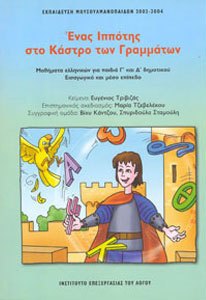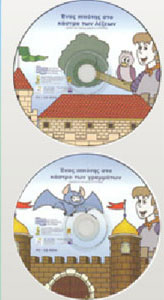

A Knight in the Castle of Letters
A Knight in the Castle of Words (2 books, 2 CD-ROMs)
A Computer-based Method of Teaching Greek as a Foreign Language
This method is intended for children between the ages of 8 to 12. It includes the basic vocabulary and all the knowledge children are expected to acquire from language classes at primary school.
The method, covering the beginner, intermediary and advanced level, comprises two parts:
1. “A knight in the castle of letters” (beginner and intermediary level).
2. “A knight in the castle of words” (intermediary and advanced level).
The course is based on a story by Eugene Trivizas. To decode the messages from his beloved princes, a knight has to find some letters, and later some words. This is how his journey and his search for the letters and words begins, in a magic place, where he meets the strangest of creatures, hears old familiar tales, travels throughout the world and sees famous monuments and sights. When he has passed certain ‘tests’ in the form of grammatical, phonological and lexical exercises, he finally acquires the letters and words he needs. In this way, the child becomes familiar with the Greek language.
«My basic idea, or rather my approach, was to write something fun that is related to language. I wrote a story about a knight in a castle of letters. It is the story of a knight in love. The princess that he loves sends him notes, but because she cries when she writes them, some letters in those notes have been erased by her tears, and, therefore, he doesn’t understand what she writes regarding where exactly they should meet. In order to find the missing letters, he has to go to the castle of letters and search for them. When writing this story, I also took into account the specific problems Minority children encounter when they use Greek. For instance, you had told me that they confused the sounds “t” (written with the letter τ - tau) and “th’ (written with the letter θ - theta), so, therefore, the knight in the story meets a “téras” (a monster) and a therío (a beast), each having a treasure of its own. The child needs to collect all the items of the treasure that start with the letter tau and give them to the téras, and collect the ones that start with the letter theta and give them to the therío … That is an entertaining adventure. »
Evgénios Trivizás, press conference of the Project (Athens, 6/17/2004).
The method uses Turkish as its “support language”, and includes automatic Turkish translation (with one click), Greek-Turkish dictionary and grammar.
The electronic method has been redesigned and released in a printed version, so as to be used in places where there are no computers. The printed version was submitted in December 2006 to the Pedagogical Institute via the Ministry’s Special Secretariat for Education of Greeks Abroad and Intercultural Education, and, after having been approved by the Institute, it was published by OEDB, the Ministry’s official printing house.
http://www.ilsp.gr/ippotis/greeklang_en.html





